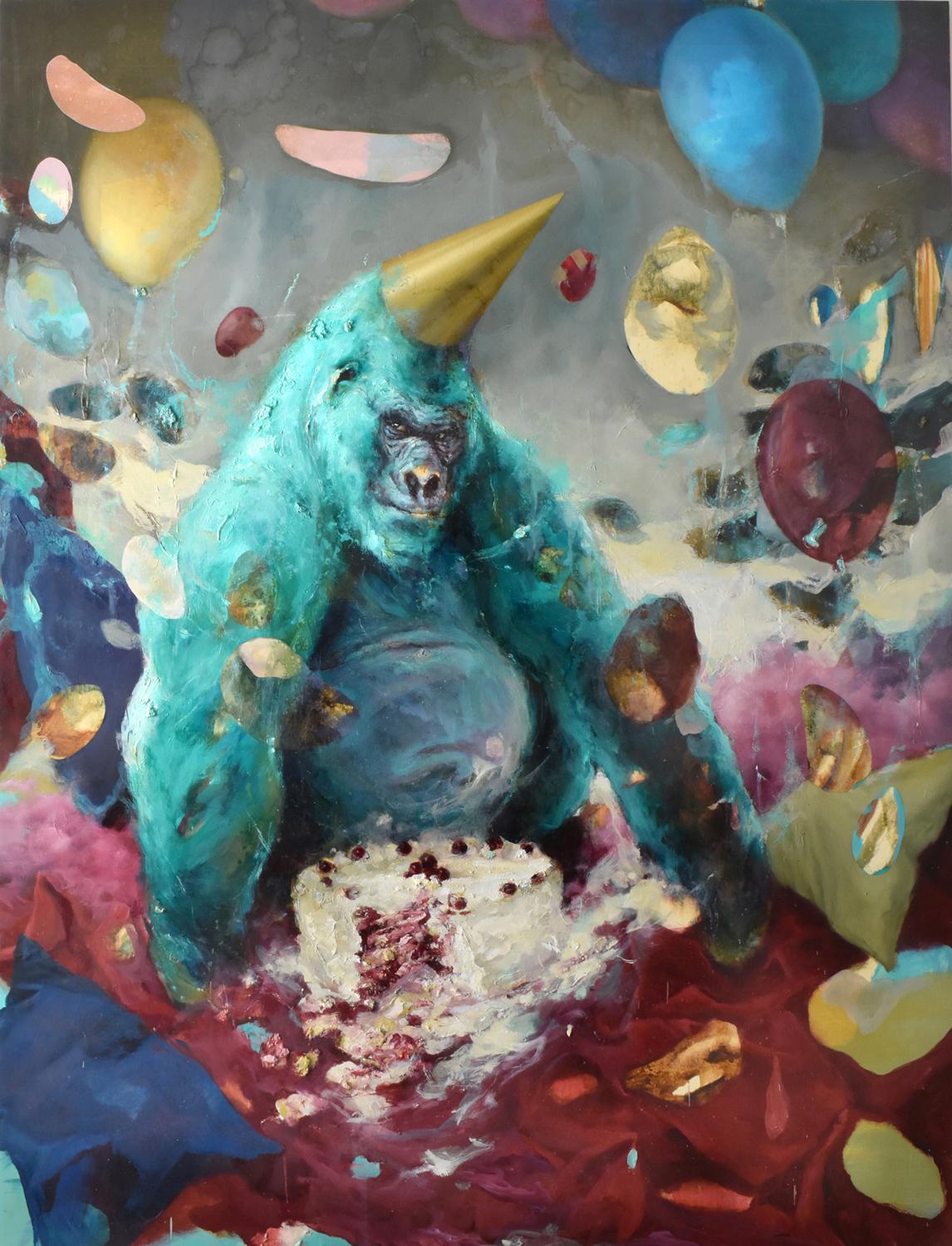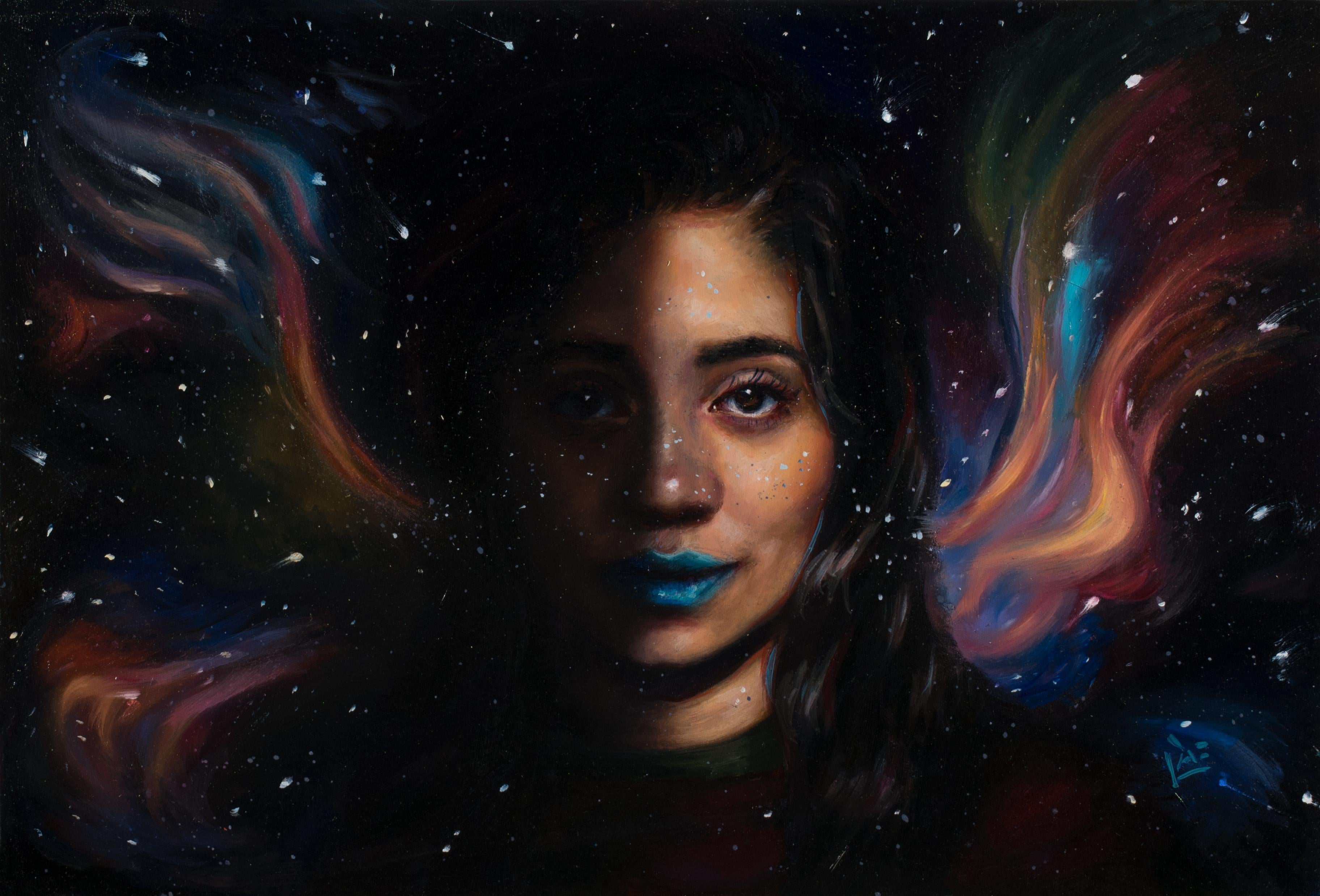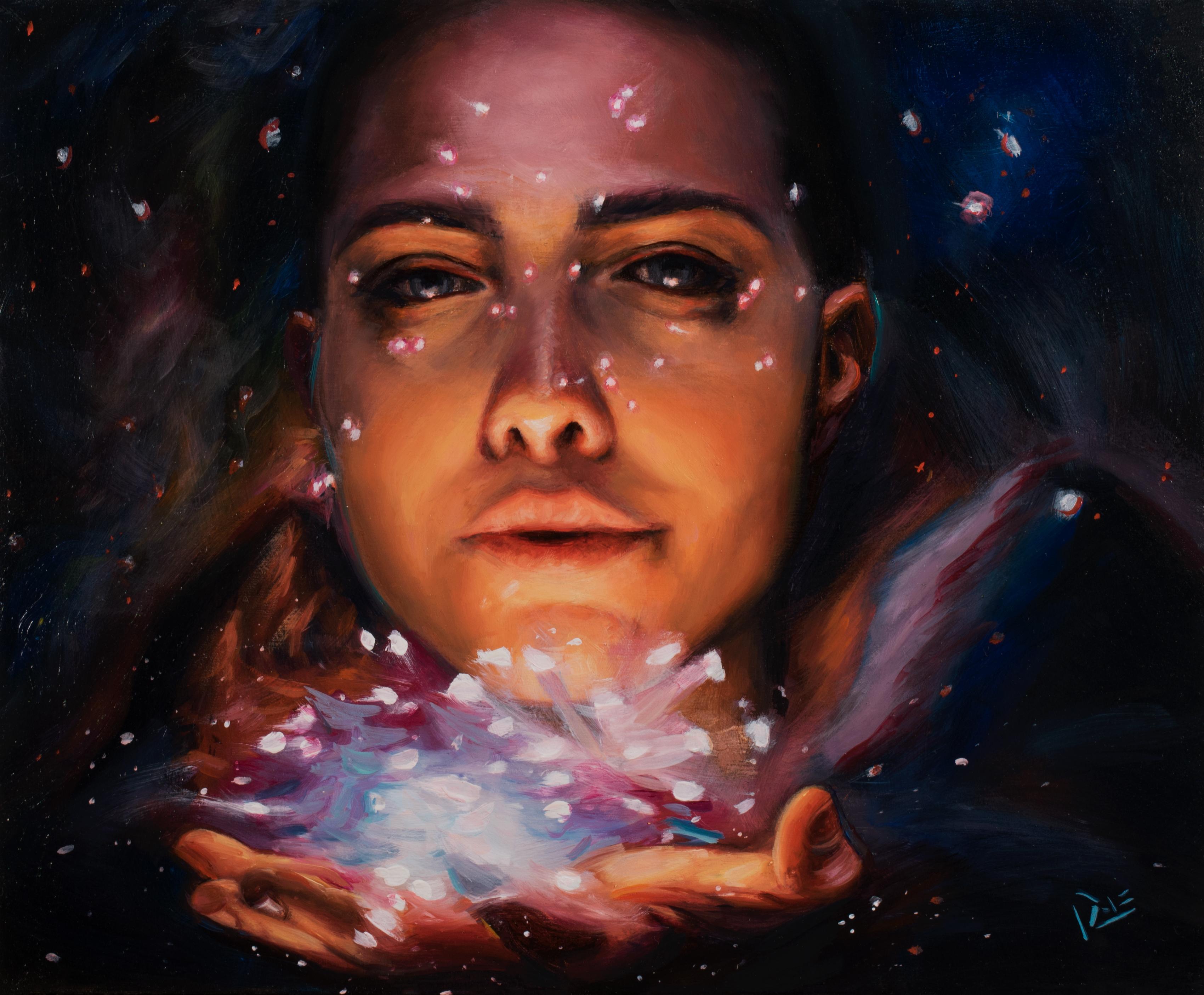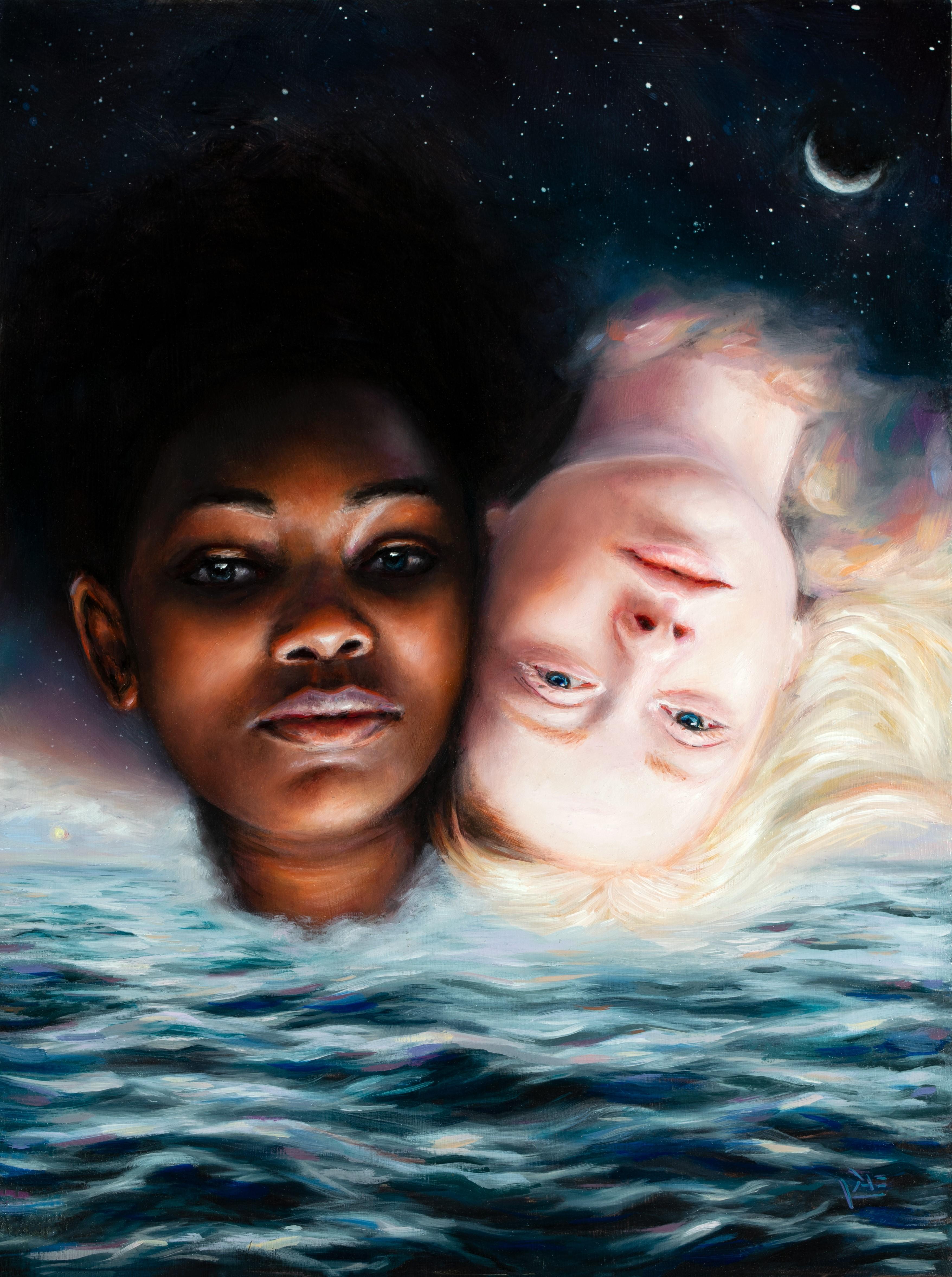Items Similar to Tlaloc and the Tiger oil painting by Julio de Diego
Want more images or videos?
Request additional images or videos from the seller
1 of 8
Julio de DiegoTlaloc and the Tiger oil painting by Julio de Diego1939
1939
About the Item
Tlaloc and the Tiger (1939)
Oil on panel
16" x 12"
23 ¾" x 18 ¾"x 2 ½" framed
Signed and dated (and inscribed) "de Diego 39" lower left.
Provenance: The artist; private collection Chicago; by descent
Exhibited: 2018 The Arts Club of Chicago, "A Home for Surrealism – Fantastic Painting in Mid-Century Chicago."
About this artist: Julio De Diego crafted a formidable persona within the artistic developments and political struggles of his time. The artist characterized his own work as “lyrical,” explaining, “through the years, the surrealists, the social-conscious painters and the others tried to adopt me, but I went my own way, good, bad or indifferent.” [1] His independence manifested early in life when de Diego left his parent’s home in Madrid, Spain, in adolescence following his father’s attempts to curtail his artistic aspirations. At the age of fifteen he held his first exhibition, set up within a gambling casino. He managed to acquire an apprenticeship in a studio producing scenery for Madrid’s operas, but moved from behind the curtains to the stage, trying his hand at acting and performing as an extra in the Ballet Russes’ Petrouchka with Nijinsky. He spent several years in the Spanish army, including a six-month stretch in the Rif War of 1920 in Northern Africa. His artistic career pushed ahead as he set off for Paris and became familiar with modernism’s forays into abstraction, surrealism, and cubism.
The artist arrived in the U.S. in 1924 and settled in Chicago two years later. He established himself with a commission for the decoration of two chapels in St. Gregory’s Church. He also worked in fashion illustration, designed magazine covers and developed a popular laundry bag for the Hotel Sherman. De Diego began exhibiting through the Art Institute of Chicago in 1929, and participated in the annual Chicago Artists Exhibitions, Annual American Exhibitions, and International Water Color Exhibitions. He held a solo exhibition at the Art Institute of Chicago in the summer of 1935. Though the artist’s career was advancing, his family life had deteriorated. In 1932 his first marriage dissolved, and the couple’s young daughter Kiriki was sent to live with friend Paul Hoffman.
De Diego continued to develop his artistic vocabulary with a growing interest in Mexican art. He traveled throughout the country acquainting himself with the works of muralists such as Carlos Merida, and also began a collection of small native artifacts. While in Mexico, de Diego made a living designing costumes and scenery for ballets. His talents continued to expand as he moved into book illustration, and his work in jewelry making was incorporated into the 1946 Modern Handmade Jewelry exhibition at the Museum of Modern Art. He remarried in 1948, becoming the third husband of Gypsy Rose Lee. The following year the two joined the traveling carnival Royal American Shows. While Gypsy worked as a performer, de Diego developed a show for the carnival using surrealist murals and the performance of Freudian themes. After three years of separation, the couple divorced in Reno, Nevada, and de Diego eventually settled in California.
Julio De Diego continued to impact the world of fine art as he produced interpretive representations of current events in an assortment of techniques. He notably worked in the Renaissance method of “velatura,” building up to as many as forty glazes of oil in each painting. He also commonly worked within gouache, graphite, and mixed media. The themes of his work were as broad in scope as the mediums he worked in, moving from surrealist and folk compositions to self-portraits and politically engaged subjects. In the time spent working for the Works Progress Administration, de Diego produced murals of landscapes and street scenes. Afterwards he pushed away from such brands of realism, asserting, “you can’t transfer nature to canvas, you have to re-invent it.” [2] His paintings of current and historical subjects became constructions both of the artist’s opinion of the facts and his vision of alternate realities. He reacted to natural disasters, produced works on World War II in a manner echoing Goya’s Disasters of War, explored the theme of atomic energy, and commented on the impact of the Cold War. His 1962 Armada series paralleled the use of technology in past and present conflict and explored the notion of defeat. The works played on apocalyptic fears of the Cold War period by invoking the infamous tragedy of the Anglo-Spanish War as well as the ultimate survival of both sides. De Diego expanded his political impact beyond the exhibition of these works, and began voicing opposition to Franco and the rise of fascism. He was a strong supporter of the radical American Artist’s Congress, which spoke in opposition to censorship and the curtailing of rights in Italy and Germany. During these years de Diego also became a teacher and took up positions at the University of Denver and the Artist Equity Workshop.
In the late sixties De Diego settled in the artist’s colony of Sarasota, Florida, and remained there until his death on August 22, 1979. Reports of his years there recounted him as an animated character who entertained with tales of past encounters with famed Surrealists Andre Breton and Max Enrst, the artist Man Ray and influential Peggy Guggenheim. De Diego continued to expand his repertoire by producing the educational film Julio de Diego—Painting in Egg Tempera with the help of local resident Jay Starker. Throughout his years, life and art remained codependent entities within the artist, who noted, “A painting is not what it is, but the memory that we have a life.” [3] Julio de Diego’s works capture the sweeping vision, ambition, and passion of a curious and multifaceted artist.
Written by Zenobia Grant Wingate
Footnotes:
[1] Peri Tucker, “Artist at Large: Julio de Diego and his worldly-wise works of art.” (St. Petersburg Times, April 1, 1962), page 8.
[2] Ibid.
[3] Marcia Corbino, “A Journey With Julio De Diego 1900-1979.”
- Creator:Julio de Diego (1900-1979, American)
- Creation Year:1939
- Dimensions:Height: 16 in (40.64 cm)Width: 12 in (30.48 cm)
- Medium:
- Movement & Style:
- Period:
- Condition:
- Gallery Location:Hudson, NY
- Reference Number:
About the Seller
5.0
Vetted Seller
These experienced sellers undergo a comprehensive evaluation by our team of in-house experts.
Established in 1973
1stDibs seller since 2023
5 sales on 1stDibs
Typical response time: <1 hour
- ShippingRetrieving quote...Ships From: Hudson, NY
- Return PolicyThis item cannot be returned.
More From This SellerView All
- Christmas Turkey & the General's Daughter painting by Julio De DiegoBy Julio de DiegoLocated in Hudson, NYThe artwork measures 18" x 24", and the frame 25" x 29.5" x 1.75". Upon request a video clip of this work may be provided. About this artist: Julio De Diego crafted a formidable per...Category
1960s Surrealist Interior Paintings
MaterialsWatercolor, Tempera, Paper
- Rescue abstract figurative oil painting by Maurice GolubovBy Maurice GolubovLocated in Hudson, NYRescue (c.1945) Oil on panel 14" x 17" 19 ½" x 22 ¼" x 1 ½" framed Signed "M. Golubov" lower right, titled "Rescue" verso. About this artist: "If you can imagine a point moving, i...Category
1940s Abstract Abstract Paintings
MaterialsOil, Panel
- Vienna Flower Market oil painting by Emil BarbariniLocated in Hudson, NYPainting measures 10 ½" x 16" and framed 20 ½" x 26" x 4"Category
1920s Impressionist Landscape Paintings
MaterialsPanel, Oil
- A Musician oil painting by Frederick E. WrightLocated in Hudson, NYThis work by Frederick E. Wright is set in an exceptional original Doll & Richards, Boston, frame. The framed dimensions are 16' x 13 1/3" x 1". A hand-written label verso (likely th...Category
Late 19th Century Abstract Impressionist Figurative Paintings
MaterialsOil, Panel
- The Lonely Road by William Charles PalmerLocated in Hudson, NYThe Lonely Road (1940) Tempera on panel 12" x 16" 19 1/2" x 23 1/2" x 1 1/2" framed Hand-signed "Palmer '40" lower center. Provenance: Midtown Galleries, New York, NY (labels verso...Category
Mid-20th Century American Modern Figurative Paintings
MaterialsPanel, Tempera
- Pleasant Thoughts oil painting by Arthur Fitzwilliam TaitBy Arthur Fitzwilliam TaitLocated in Hudson, NYThis painting is listed in the W.H. Cadbury and H.F. Marsh book Arthur Fitzwilliam Tait: Artist in the Adirondacks, Newark, Delaware, 1986, no.59.36t. It is hand-signed "AF Tait...Category
1850s Hudson River School Figurative Paintings
MaterialsOil, Canvas
You May Also Like
- Happy DayLocated in Natchez, MSCavagnaro again toys with anthropomorphism. This work is a playful mirror, as the artist encourages the viewer to see themselves in the subject.Category
2010s Surrealist Animal Paintings
MaterialsOil, Wood Panel
- "Shadow Self", Oil paintingLocated in Denver, COTiffany Dae's (US based) "Shadow Self" is a original, handmade oil painting that depicts a feminine face with blue lipstick fading into the darkness of spa...Category
2010s Surrealist Portrait Paintings
MaterialsOil, Panel
- "Don't Say it Outloud", Oil paintingLocated in Denver, COTiffany Dae's (US based) "Don't Say it Outloud" is a original, handmade oil painting that depicts a feminine face surrounded by darkness, gently holding an...Category
2010s Surrealist Portrait Paintings
MaterialsOil, Panel
- "Sea and Stars", Oil paintingLocated in Denver, COTiffany Dae's (US based) "Sea and Stars" is a original, handmade oil painting that depicts an African American face and a Caucasian face transposed over th...Category
2010s Surrealist Portrait Paintings
MaterialsOil, Panel
- "Pocket Full of Dreams", Oil paintingLocated in Denver, COTiffany Dae's (US based) "Pocket Full of Dreams" is a original, handmade oil painting that depicts a feminine figure surrounded by darkness, gently holding...Category
2010s Surrealist Portrait Paintings
MaterialsOil, Panel
- "Into the Night, " Oil PaintingLocated in Denver, COSara Scribner's (US based) "Into the Night" is an original, handmade oil painting that depicts a woman in a long pink dress walking towards a background ...Category
2010s Surrealist Figurative Paintings
MaterialsPanel, Oil
Recently Viewed
View AllMore Ways To Browse
Girl With The Cat
James David Sofa
Tetiana Pchelnykova
Carousel Toronto
Morakinyo Femi
Moroccan Door Panels For Outdoors
Angels Saints And Sinners
Charlie Russell Oil Western
Green Goblin
Pat Lasch
Vincent Van Gogh Cafe Terrace
Henry Salem Hubbell
Lindokuhle Khumalo
Rehs And Co
Large Sea Horse Painting
Painting Of Girl In Garden
Dancing Ballerinas Paintings
Saudi Edition





